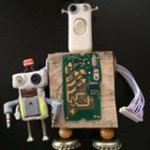Search the Community
Showing results for tags 'nanopiair'.
-
Hello all, I'm working on a project where I need at least 460800 baud on a UART on the NanoPi Neo Air. Works great at lower baud rates but can't seem to get it much faster than 115200. Any thoughts on clock adjustment or CPU speed? I'm using Armbian 5.24 with the 3.X kernel
-
Hi, I got a new nano pi neo air and wanted to add a microphone to record sound. First I tried my USB mic and it worked without any problem then I saw a topic in here: https://forum.armbian.com/index.php?/topic/3598-nano-pi-neo-air-mic-audio-out/ According to this topic, I can attach a mic to the pins that mentioned. But my big problem is what is the hardware name? I tried to use arecord -l and the output was: root@NanoPi-NEO-Air:~# arecord -l **** List of CAPTURE Hardware Devices **** card 1: sndhdmi [sndhdmi], device 0: SUNXI-HDMIAUDIO sndhdmi-0 [] Subdevices: 1/1 Subdevice #0: subdevice #0 But it is the HDMI sound card which I think is not right. How can I record sound with the attached mic? Thanks.
-
This is a rather interesting board isn't it? H3, GPIO, 0.5GB memory. http://www.cnx-software.com/2016/07/07/smaller-than-raspberry-pi-zero-meet-nanopi-neo-arm-linux-development-board/ Would it be possible to run this on Armbian?
-
Hi All, I use ARMBIAN 5.25 stable Ubuntu 16.04.2 LTS 3.4.113-sun8i on Nano Pi Neo Air and I try : dpkg-reconfigure lirc I select my remote and then my transmitter nicely After configure, I have this error: ls: cannot access '/lib/modules/3.4.113-sun8i/kernel/drivers/staging/media/lirc': No such file or directory I tried : apt-get install lirc-modules-source But It has no installation candidate... Do someone know how can I do ? Best Regards
-
Hi everyone. I heard Armbian was the to-go distribution for the Nanopi NEO Air. I've got a bunch of these boards where I'd like to use the built-in Bluetooth and Wi-Fi capability in a small form factor for a project. I don't need video or audio or other functionality. I see a legacy kernel "stable build" and a mainline kernel "experimental" build. For the experimental build it lists the following known problems: No Mali drivers No hardware accelerated video decoding schedutil CPU governor may cause clicks and pops on audio output – change(d) to ondemand to work around this issue This sounds fine with me. I need no video, and no audio. I also see from the documentation: Is this still currently the case? Would using mainline kernel potentially overheat the board if there is a processing load on it? Lastly, what else about this experimental mainline kernel board for the Nanopi NEO Air should I be keeping in mind in case it's not well-documented but known to people using this board that might be relevant to me?
-
I want to use a shutdown button to make a secure shutdown with the nanopi neo air. But i am completly lost how it works. I don't find out, which GPIO's i can use for a script. And if i need a puuldown or not. Can somebody help me? Thanks Chris
-
Hello is there any way to stream rtsp on H3 devices? With this i can record video ffmpeg -t 30 -f v4l2 -channel 0 -video_size 1280x720 -i /dev/video0 -pix_fmt nv12 -r 30 -b:v 64k -c:v cedrus264 test.mp4 My hardware is NanoPI neo air + CAM500B. Using friendlyARM's image at the moment because camera don't work on Armbian. (/dev/video0 is there but mjpg-streamer end with errors for example)
-
Hi, is it possible to install armbian on the emmc and a second armbian on the microsd card? So, if no microsd card insert the nanopi boot from emmc, otherwise boot from microsd?
-
Hey folks, I'm hoping for some advice on achieving decent graphics for my application. I've got a prototype running with a custom board hosting the NanoPi Neo Air and a bunch of my own hardware. The biggest issue right now is getting reasonable graphics performance. The difference between mainline and legacy support has had me confused and switching back and forth trying to find a useful solution. Here's what I've learned so far: Mainline feels like the future, so that's my preference. My application uses fbtft over SPI for the graphics. I achieved 72MHz SPI on mainline which gives almost reasonable performance. On legacy the SPI driver seems buggy and locks up after random intervals. It never worked at more than 32MHz or so... too slow for my screen. (this happened to me on Raspbian too) So far my application is built on SDL2 which I now learn is not supported by fbdev. I would run X if there was an advantage... but it just feels like more layers unless I can use Mali to get some hardware acceleration. I could port my app to SDL1.2 and use fbdev without X... but that feels like a backwards move also. Not related to graphics, but mainline still has no i2s support on H3, which I need but apparently it's coming soon. Does this work reliably (slave mode) on legacy? So I think the showstoppers for using the legacy kernel are: Afraid of developing something new against an old kernel Lack of understanding of FEX files, although maybe it's not so bad SPI bug causing random lockup of the graphics... is there a known workaround for this problem? If someone could point me in the right direction that would be great. I feel like I'm going around in circles. Thanks!
-
Hi, I am using ARMBIAN 5.25 stable Ubuntu 16.04.2 LTS 3.4.113-sun8i on my Nanopi neo air. uname -a says Linux nanopiair 3.4.113-sun8i #10 SMP PREEMPT Thu Feb 23 19:55:00 CET 2017 armv7l armv7l armv7l GNU/Linux I think, since I made the last apt-get upgrade and rebooted, my bluetooth stopped working. lsmod gives: lsmod Module Size Used by bmp085 3487 0 pcf8591 3363 0 snd_usb_audio 80352 0 snd_hwdep 5562 1 snd_usb_audio snd_usbmidi_lib 17545 1 snd_usb_audio snd_rawmidi 17134 1 snd_usbmidi_lib gspca_ov534 9254 0 gspca_main 19688 1 gspca_ov534 g_serial 27617 2 dhd 666855 0 hidp 12949 0 rfcomm 32879 0 hci_uart 20384 0 bluetooth 174097 5 hidp,hci_uart,rfcomm btrfs 712409 0 on another neo air with older system Linux nanopiair 3.4.113-sun8i #28 SMP PREEMPT Thu Feb 2 02:01:28 CET 2017 armv7l armv7l armv7l GNU/Linux lsmode it said: Module Size Used by bnep 9617 2 bmp085 3487 0 pcf8591 3363 0 g_serial 27617 2 dhd 666855 0 hidp 12949 0 rfcomm 32879 0 hci_uart 20384 1 bluetooth 174097 25 bnep,hidp,hci_uart,rfcomm btrfs 712409 0 I also tried to install a nightly build Armbian_5.26.170227_Nanopiair_Ubuntu_xenial_dev_4.10.0 but there was no bluetooth on this build as well. Any Ideas, what I can do to get my hci0 device back? Thank you very much and best regards, David
-
Hi there, I recently purchased a NanoPi NEO Air from FriendlyElec with a CAM500B module. It works alright with the mjpg-streamer and their provided Ubuntu Core. I built an Arabian 5.27 Nano Pi Air Debian Jessie image with the default kernel and the device is no longer found. I've forced the load of ov5640 and vfe_v4l2 in /etc/modules, but /dev/video0 isn't appearing. The kernel log has this in it when the module is loaded: [ 116.519650] [OV5640@lex]init_sensor - frame_rate: 0, max_win_size: 11 If I boot back to Ubuntu Core via SD, the camera is back.
-
Hi, I just got a NanoPi Neo Air, and I've tried both legacy jessie and ubuntu, as well as the nightly build, and with all three I have been unable to find the onboard wifi. When I run iwconfig, there is no sign of a wifi module; when I try nmtui there is nothing there to activate. lsmod shows the following: Module Size Used by evdev 9979 1 sun8i_codec_analog 13766 0 snd_soc_core 115473 1 sun8i_codec_analog snd_pcm_dmaengine 4221 1 snd_soc_core snd_pcm 70145 2 snd_pcm_dmaengine,snd_soc_core sun8i_ths 3134 0 gpio_keys 8517 0 uio_pdrv_genirq 3354 0 cpufreq_dt 3522 0 uio 8012 1 uio_pdrv_genirq thermal_sys 43232 2 cpufreq_dt,sun8i_ths g_serial 3737 0 libcomposite 34692 1 g_serial brcmfmac 165505 0 brcmutil 6270 1 brcmfmac cfg80211 192770 1 brcmfmac rfkill 10928 2 cfg80211 Is one of these the WiFi module? ifup wlan0 reported the following root@nanopiair:~# ifup wlan0 wlan0: ERROR while getting interface flags: No such device Error for wireless request "Set Mode" (8B06) : SET failed on device wlan0 ; No such device. Error for wireless request "Set Power Management" (8B2C) : SET failed on device wlan0 ; No such device. wpa_supplicant: cannot read contents of /etc/wpa_supplicant/wpa_supplicant.conf run-parts: /etc/network/if-pre-up.d/wpasupplicant exited with return code 1 Failed to bring up wlan0. WiFi works fine with the FA distribution from https://www.mediafire.com/folder/sr5d0qpz774cs/NanoPi-NEO_Air#oc15bwqbuxgxe. What am I doing wrong? Thanks very much.
-
Hi, I am new to nano-pi air neo. I am trying to get analog audio from the device. I had no success with the four connectors near to the camera connector. But if I connect the speaker to the DOUT of the audio, I get the sound but with lots of noises. How can I play audio in this device ? Am I missing something here ? Thank You.
-
Hi, I was looking the wiki, but I didn't find if is it possible to connect a RJ45 jacket to Nano PI NEO Air. If yes, what are the pins? Best regards, Marcos Sousa
-
Why not to add lirc_gpio support to NanoPiNeo Air ? Even if it is not planned, I try to use this patch : https://github.com/igorpecovnik/lib/blob/master/patch/kernel/sun7i-default/0050-lircgpio_and_raw.patch Kernel compilation is ok for me : apt-get -y install git git clone https://github.com/igorpecovnik/lib --depth 1 cp lib/compile.sh . ./compile.sh I try to apply this patch now : ~/crosscompile/lib/patch/kernel/sun7i-default/0050-lircgpio_and_raw.patch I expected to have a lircgpio.ko somewhere, but nothing. Is there a procedure or a tutorial or some help to build a driver ?
-
Hello All, I am on NanoPiAir, I really want to use my home made ir receiver with this board haha So I try : insmod /lib/modules/3.4.113-sun8i/kernel/drivers/media/rc/gpio-ir-recv.ko and I have : insmod: ERROR: could not insert module gpio-ir-recv.ko: Unknown symbol in module In another side I tried to build a lircgpio.ko with a patch but I can't find the .ko generated despite kernel compilation succeed. If someone can help, this should be great
-
Hello, I have a special Ir Receiver which works on a raspberry but not on nano pi neo air... input levels are different ? I can receive signal (I have pulses and spaces) but datas are corrupted and I must transmit longer to have a proper result... Is it possible to change Lirc input pin ?
-
Hi, I have nanopi neo air and want to use Ethernet over USB (micro USB on the board). I configured CDC_Ethernet and RNDIS on kernel's(Debian Jessie) USB gadget section. With ifconfig, usb0 is in the list and with dmesg, it seems g_ether has been configured and it is ready but noting happens on windows nor Linux to show any active network connection or even usb connection on device manager... Please help how can i use usb to have ethernet ... BR, Masoud
-
Hello, I try to get WiFi P2P working on the Nano Pi Neo Air with a 4.x mainline kernel and so I tried the latest available nightly build "Armbian_5.24.170118_Nanopiair_Ubuntu_xenial_4.9.4.img" but I have problems to establish a connection. Does anybody have WiFi P2P working on the Nano PI Neo Air? The problem seems be a problem with the P2P_CLIENT interface creation at the brcmfmac driver. My P2P test peer is a Nexus 5 phone and I'am able to see the peer device using wpa_cli p2p_peers. But when I try to connect I get following driver error messages at the Kernel Log. [ 8.085540] brcmfmac: brcmf_c_preinit_dcmds: Firmware version = wl0: Jun 6 2014 14:50:39 version 7.10.226.49 ® FWID 01-8962686a [ 83.057486] brcmfmac: brcmf_do_escan: error (-110) [ 83.062334] brcmfmac: brcmf_cfg80211_scan: scan error (-110) [ 85.611612] brcmfmac: brcmf_sdio_bus_rxctl: resumed on timeout [ 85.617463] brcmfmac: brcmf_p2p_tx_action_frame: sending action frame has failed [ 85.625002] brcmfmac: brcmf_p2p_send_action_frame: Failed to send Action Frame(retry 1) [ 88.171615] brcmfmac: brcmf_sdio_bus_rxctl: resumed on timeout wpa_supplicant log: p2p-dev-wlan0: Control interface command 'P2P_CONNECT 36:fc:ef:a4:be:2c pbc' p2p-dev-wlan0: Determining shared radio frequencies (max len 1) p2p-dev-wlan0: Shared frequencies (len=0): completed iteration p2p-dev-wlan0: Shared frequencies (len=0): valid for P2P p2p-dev-wlan0: Determining shared radio frequencies (max len 1) p2p-dev-wlan0: Shared frequencies (len=0): completed iteration p2p-dev-wlan0: P2P: num_unused_channels: 1 P2P: Setup freqs: freq=0 num_MCC=1 shared_freqs=0 num_unused=1 P2P: Current operating channels are not available for P2P. Try to use another channel P2P: Own frequency preference: 0 MHz P2P: Create a new interface p2p-wlan0-0 for the group nl80211: Create interface iftype 8 (P2P_CLIENT) Failed to create interface p2p-wlan0-0: -110 (Connection timed out) P2P: Failed to create new group interface P2P: Failed to allocate a new interface for the group wpa_supplicant is started as following: wpa_supplicant -B -iwlan0 -c/etc/p2p_supplicant.conf -f /var/log/wpa_supplicant.log -dd p2p_supplicant.conf: ctrl_interface=/var/run/wpa_supplicant update_config=1 device_name=NANO-P2P device_type=1-0050F204-1 config_methods=virtual_push_button physical_display keypad p2p_go_intent=1 country=US p2p_no_group_iface=1 Thank you, Steve
-
Hi guys, first I want to thank you for your marvelous work. I've learned much... I've ordered a Nano Pi Neo Air and two Nano Pi Neo from Friendly Arm which arrived last week to build some squeezelite clients and drop them around the house. At the moment I'm just using some cheap USB-C-Media Soundcards but plan to invest in better ones, if the multi-room solution I have in mind is used enough. The Nano Pi Neo (not Air) does exactly what it should using the Ubnuntu Xenial Image from the download page. Cheers! For the Air's I've used the Debian release, don't know really why ;-) At first I've bootet it from a SD-Card after a direct eMMC-Flash using https://github.com/ThomasKaiser/sunxi-armbian-flasher-osxfailed. Etcher always mouns about not finding diskutil (tried 1.0.0beta15 and 1.0.0beta17 - OSx 10.12.2) on the first run. After restarting Etcher it shows the "drive" and I can flash, but after that mmc1 could not be found as stated on the serial console - that seems like another problem and I did not copy the message, sorry. I've installed Debian from the SD-Card to the eMMC with /usr/lib/nand-sata-install/nand-sata-install.sh which worked fine. Cheers again! After that I've configured Wifi by editing /etc/network/interfaces and adding an auto wlan0. After restarting networking - online! Everything seems to work fine, installing Squeezelite, configuring it and listening to music from the Logitech-Media-Server in sync with the other Nano Pi's. WOW! I'm using a dedicated power supply (5V, 2A) and attached the usb-sound-dongle via an OTG-Y-Cable together with the 5V. http://imgur.com/a/Ta3iB But something seems quirky. I can't get a stable ssh connection via Wi-Fi - Serial works fine meanwhile. After some time listening to music from the device, it drops from the player list in the media server and won't come back again while it is still pingable. The load of the board is somewhere around 0.02-0.16 the whole time. This is a ping to the device: PING nanopiair.fritz.box (192.168.42.165): 56 data bytes 64 bytes from 192.168.42.165: icmp_seq=0 ttl=64 time=149.826 ms 64 bytes from 192.168.42.165: icmp_seq=1 ttl=64 time=64.753 ms 64 bytes from 192.168.42.165: icmp_seq=2 ttl=64 time=85.062 ms 64 bytes from 192.168.42.165: icmp_seq=3 ttl=64 time=104.953 ms 64 bytes from 192.168.42.165: icmp_seq=4 ttl=64 time=27.079 ms 64 bytes from 192.168.42.165: icmp_seq=5 ttl=64 time=4.260 ms 64 bytes from 192.168.42.165: icmp_seq=6 ttl=64 time=4.676 ms 64 bytes from 192.168.42.165: icmp_seq=7 ttl=64 time=3.576 ms 64 bytes from 192.168.42.165: icmp_seq=8 ttl=64 time=5.415 ms 64 bytes from 192.168.42.165: icmp_seq=9 ttl=64 time=4.240 ms 64 bytes from 192.168.42.165: icmp_seq=10 ttl=64 time=4.242 ms [...] 64 bytes from 192.168.42.165: icmp_seq=1990 ttl=64 time=4.391 ms 64 bytes from 192.168.42.165: icmp_seq=1991 ttl=64 time=4.363 ms 64 bytes from 192.168.42.165: icmp_seq=1992 ttl=64 time=4.313 ms 64 bytes from 192.168.42.165: icmp_seq=1993 ttl=64 time=31.534 ms 64 bytes from 192.168.42.165: icmp_seq=1994 ttl=64 time=52.714 ms 64 bytes from 192.168.42.165: icmp_seq=1995 ttl=64 time=72.956 ms 64 bytes from 192.168.42.165: icmp_seq=1996 ttl=64 time=94.694 ms 64 bytes from 192.168.42.165: icmp_seq=1997 ttl=64 time=13.832 ms 64 bytes from 192.168.42.165: icmp_seq=1998 ttl=64 time=37.470 ms 64 bytes from 192.168.42.165: icmp_seq=1999 ttl=64 time=60.732 ms 64 bytes from 192.168.42.165: icmp_seq=2000 ttl=64 time=80.521 ms 64 bytes from 192.168.42.165: icmp_seq=2001 ttl=64 time=100.608 ms 64 bytes from 192.168.42.165: icmp_seq=2002 ttl=64 time=18.236 ms 64 bytes from 192.168.42.165: icmp_seq=2003 ttl=64 time=38.494 ms 64 bytes from 192.168.42.165: icmp_seq=2004 ttl=64 time=57.605 ms 64 bytes from 192.168.42.165: icmp_seq=2005 ttl=64 time=77.558 ms 64 bytes from 192.168.42.165: icmp_seq=2006 ttl=64 time=97.405 ms 64 bytes from 192.168.42.165: icmp_seq=2007 ttl=64 time=14.296 ms 64 bytes from 192.168.42.165: icmp_seq=2008 ttl=64 time=37.039 ms 64 bytes from 192.168.42.165: icmp_seq=2009 ttl=64 time=61.979 ms 64 bytes from 192.168.42.165: icmp_seq=2010 ttl=64 time=79.827 ms 64 bytes from 192.168.42.165: icmp_seq=2011 ttl=64 time=104.190 ms 64 bytes from 192.168.42.165: icmp_seq=2012 ttl=64 time=5.220 ms 64 bytes from 192.168.42.165: icmp_seq=2013 ttl=64 time=8.095 ms 64 bytes from 192.168.42.165: icmp_seq=2014 ttl=64 time=6.569 ms 64 bytes from 192.168.42.165: icmp_seq=2015 ttl=64 time=5.788 ms 64 bytes from 192.168.42.165: icmp_seq=2016 ttl=64 time=6.476 ms So, no packet drops - only very varying packet round trip times. Here's my iwconfig (WPA2): wlan0 IEEE 802.11 ESSID:"myssid" Mode:Managed Frequency:2.462 GHz Access Point: XX:XX:XX:XX:XX:XX Bit Rate=72 Mb/s Tx-Power:32 dBm Retry min limit:7 RTS thr:off Fragment thr:off Encryption key:off Power Managementmode:All packets received Link Quality=5/5 Signal level=-34 dBm Noise level=-91 dBm Rx invalid nwid:0 Rx invalid crypt:0 Rx invalid frag:0 Tx excessive retries:77 Invalid misc:0 Missed beacon:0 Maybe the excessive retries are a hint? On the shell I have to wait for 10 or more seconds to type in another command or character. Serial, as already said, responds quick as usual. Maybe I've choosed the wrong antenna? But then the iwconfig should tell other values. I bought these: https://www.amazon.de/gp/product/B01FZ47URG/ref=oh_aui_detailpage_o03_s00?ie=UTF8&psc=1 Hopefully you can point me out what I could do to have reliable Wi-Fi on the otherweise fine Nano Pi Neo Air board. Though I'm not using them to do heavy lifting. Regards, Patrik
-
Hi, I am using Armbian for NanoPI NEO AIR + CAM500B. I am unable to see any /dev/video0. I am able to get the camera working with FA default image. Here is my dmeg output. I really appreciate any help to get this working. I would like to use OV5640 with https://github.com/avafinger/ov5640driversto control frame rate. Thanks
-
Edit: Price seems to be $17.99 Just FYI: FriendlyARM is preparing another H3 board: NanoPi Air somehow related to NanoPI NEO (same low default DRAM clockspeed let me believe this). What we already know (by looking at Github commits): onboard eMMC (no idea about the size) no HDMI no Ethernet AP6212 based WiFi+BT (connected through SDIO and UART) Personal assumptions: most probably also just a single bank DRAM configuration most probably also a SD card slot maybe eMMC only an option and a basic version without eMMC available same 40 x 40 mm dimensions as NEO, eMMC on the lower PCB side next to H3, AP6212 on the upper (where the Ethernet Jack is located on the NEO -- assumption based on heatsink design for NEO) Therefore adding Armbian support for this board is pretty easy as soon as we're done with NanoPi NEO since it's then just combining settings for NanoPi NEO with Banana Pi M2+ (WiFi/BT). No official announcement available yet and no traces in FA's wiki. But since the FriendlyARM folks follow the 'release often, release early' principle most information can be gathered from Github sources
-
First sorry for starting a similar thread here and in [1]. I try to read a DS18B20, which does not work with Armbian, DietPi, and Friendlyarm's Ubuntu. This morning, my idea was to slow down the CPU - and it worked. In detail: By running some useless cpu consuming python scripts, reading the DS18B20 works fine. As soon as i stop them, reading the sensor immediately fails. So there might be some timing issues in the implementations of w1-gpio and w1-gpio-board. Are there any hints how i can get these issues fixed? Thanks! Thomas [1] http://www.friendlyarm.com/Forum/viewtopic.php?f=47&t=393
-
So I have installed Armbian on a number of boards in the past without real issue. I'm currently installing the latest version (not nightly build or anything) on my new NanoPi NEO AIR. A couple of points. Firstly - WIFI seems weak on the internal aerial - I set everything up on the serial port but once I used WINSCP - I note the terminal is slow - despite apt-get-update and other installs seeming to run pretty well. Secondly (and this has never happened before) it is now 7th of November early in the morning and my script for installing programs seemed to be running into issues until I realised the board time was set 6 days in the past (I only installed Armbian last night) - never had that happen. I changed the date mid-stream and all seems to be installing ok... it will be some time before the script is complete but looking ok up to now.








